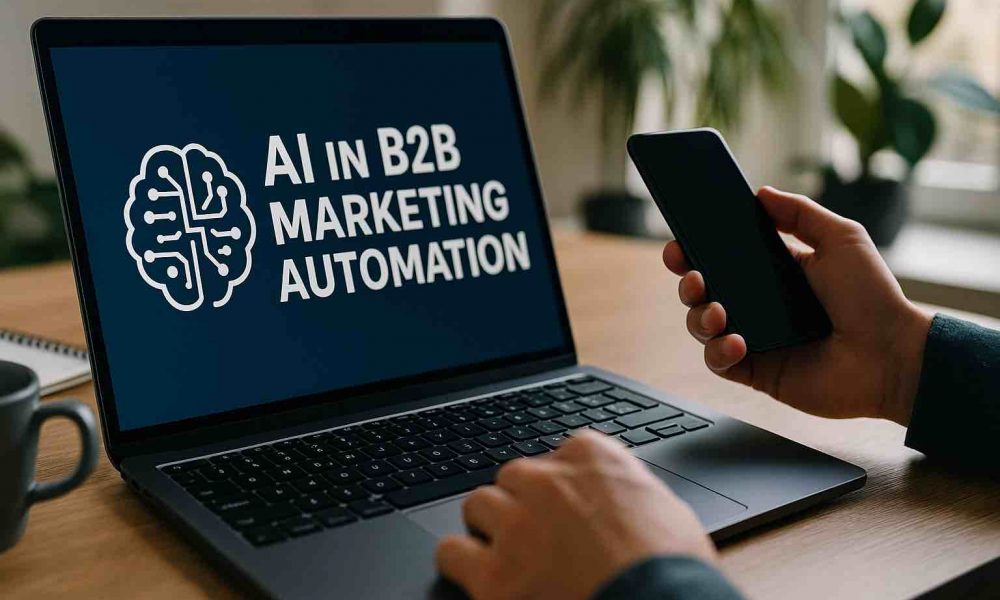Top benefits of Growth Systems For B2B for B2B customer engagement
Wiki Article
AI Automation for B2B: Techniques to Boost Your Service Efficiency
AI automation in the B2B market offers a critical possibility for organizations to improve their performance. By enhancing and improving procedures decision-making, businesses can accomplish substantial efficiencies. Nonetheless, the effective integration of AI needs mindful consideration of different variables. Understanding which areas to automate and choosing proper tools are just the beginning. The capacity for transformation elevates crucial inquiries concerning execution and ongoing examination. What approaches will guarantee long lasting success in this developing landscape?Recognizing AI Automation in B2B Context
As businesses increasingly seek efficiency and advancement, comprehending AI automation in the B2B context ends up being crucial. AI automation leverages sophisticated technologies to streamline processes, boost decision-making, and boost general productivity. By incorporating AI tools, firms can enhance procedures such as supply chain monitoring, client connection monitoring, and data evaluation. These modern technologies can assess vast amounts of information quickly, offering workable insights that drive strategic initiatives. In addition, AI-driven automation minimizes human mistake and liberates workers to concentrate on more complex tasks. By cultivating cooperation between human knowledge and maker capacities, organizations can accomplish a competitive edge. Inevitably, recognizing AI automation is essential for B2B organizations aiming to prosper in a significantly digital marketplace.Recognizing Areas for Automation
In the quest for reliable AI automation in B2B, it is important to determine specific locations where automation can yield considerable benefits. This includes assessing job monotone, exploring chances for data handling, and pinpointing operations traffic jams. By concentrating on these elements, companies can enhance operations and boost efficiency.Job Repetitiveness Evaluation
Task monotone assessment plays an essential function in recognizing locations ripe for automation within B2B procedures. Minarik AI. This procedure entails evaluating daily jobs to identify which are taxing and repetitive, therefore impeding efficiency (AI Automation For B2B). By looking at workflows, organizations can pinpoint certain features that require extreme hand-operated input, such as data access, invoice processing, or client follow-ups. Identifying these repeated jobs permits companies to allocate resources extra effectively, boosting overall effectiveness. In addition, automation can reduce human error, simplify operations, and maximize staff members to concentrate on higher-value tasks. Conducting a thorough task repetitiveness assessment empowers B2B organizations to embrace targeted automation techniques, ultimately driving enhanced efficiency and affordable benefit in the industryData Processing Opportunities

Operations Bottleneck Identification
Recognizing workflow bottlenecks is an essential action in realizing the full benefits of automation within B2B companies. These bottlenecks usually manifest as delays, resource restrictions, or ineffective processes that prevent performance. To efficiently determine these areas, organizations can perform complete analyses of their operations, making use of metrics such as cycle time and throughput. Engaging staff members in conversations about pain points can additionally offer valuable insights. Once traffic jams are determined, companies can prioritize them based on influence and expediency for automation. By purposefully attending to these inefficiencies, B2B firms can simplify operations, improve collaboration, and eventually improve general efficiency. This proactive technique to operations evaluation lays the foundation for successful automation efforts that drive organization development.Picking the Right AI Tools and Technologies
As services increasingly transform to AI to enhance their operations, choosing the right devices and technologies ends up being vital for attaining desired results. Organizations should evaluate their particular requirements and purposes, taking into consideration factors such as user-friendliness, compatibility, and scalability. An extensive market evaluation can aid identify leading AI services customized for their market. In addition, organizations need to evaluate the technical facilities needed to sustain these devices, ensuring seamless combination with existing systems. Data safety and conformity with policies are also critical factors to consider that affect device choice. By focusing on these standards, firms can make educated decisions that drive efficiency and performance, ultimately leading to boosted organization efficiency. The right AI tools empower companies to innovate and keep an one-upmanship in the marketplace.Creating a Strategic Implementation Strategy
A successful tactical implementation plan for AI automation in B2B requires plainly specified essential objectives. Additionally, companies need to evaluate their current capacities to recognize spaces and opportunities for renovation. Constant monitoring and adjustment of the strategy will ensure positioning with developing organization requirements and technology improvements.Define Trick Goals
To guarantee effective AI automation in B2B environments, defining crucial objectives is crucial for establishing a tactical implementation plan. Organizations has to determine details, measurable objectives that align with their general business method. This clearness gives a roadmap for the automation process, making sure that efforts are concentrated on areas that will certainly yield the greatest influence. Trick goals might include enhancing functional efficiency, boosting consumer contentment, or enhancing profits. Setting these purposes allows teams to focus on resources properly and track progress gradually. In addition, clear goals facilitate better communication among stakeholders, promoting collaboration and positioning throughout the company. Inevitably, distinct objectives act as the foundation for a robust AI automation approach that drives service performance.Assess Current Abilities
Before carrying out AI automation, companies must completely evaluate their present capacities to identify weaknesses and toughness. This assessment includes taking a look at existing modern technologies, labor force abilities, and functional processes. By carrying out a comprehensive audit, organizations can pinpoint locations that call for enhancement or investment. Organizations must additionally consider their information administration methods, as the quality and access of information are essential for effective AI assimilation. Recognizing the current technical landscape makes it possible for firms to align their sources and capacities with their calculated goals. Additionally, it is vital to review company society and preparedness for change, as these aspects considerably influence the fostering of AI options. This evaluation acts as the structure for establishing a strategic execution plan that makes best use of the possibility of AI automation.Display and Adjust
Applying AI automation calls for a vibrant method that stresses constant surveillance and adjustment. Businesses have to establish a critical application strategy that incorporates normal assessments of AI efficiency against predefined metrics. This involves monitoring essential efficiency indicators (KPIs) to examine the effectiveness of automation options. By evaluating information, companies can identify areas for renovation and fine-tune their AI systems as necessary. Involving with stakeholders throughout the process ensures that the automation straightens with company goals and customer needs. Additionally, cultivating check my blog a society of adaptability enables business to respond promptly to changing market conditions and technological innovations. Growth Systems For B2B. Inevitably, continuous tracking and adjustment not just boost operational efficiency however also drive continual business performance in the affordable B2B landscapeEnsuring Data Top Quality and Combination
As organizations progressively count on AI automation in B2B processes, guaranteeing data high quality and combination comes to be vital for success. Top notch information is crucial for exact analytics, educated decision-making, and reliable consumer involvement. Information have to be cleansed, standard, and confirmed to remove mistakes and variances that could cause misdirected insights. Additionally, seamless combination throughout different platforms and systems is crucial; diverse data silos hinder automation initiatives and lower functional efficiency. Organizations should adopt durable information governance frameworks and use sophisticated tools to facilitate information combination while maintaining quality criteria. By focusing on these elements, businesses can improve their AI automation efforts, ultimately leading to boosted performance and an affordable benefit in the B2B landscape.Measuring Success and ROI of AI Initiatives
Just how can organizations effectively determine the success and return on financial investment (ROI) of their AI initiatives? To determine efficiency, businesses need to develop clear, quantifiable objectives aligned with critical objectives. Key performance indications (KPIs) such as expense savings, income development, and efficiency renovations can give beneficial insights. Organizations often carry out baseline assessments prior to executing AI, allowing them to compare pre- and post-implementation metrics. Furthermore, analyzing consumer fulfillment and involvement can reveal the effect of AI on individual experience. Frequently assessing these metrics helps in refining AI methods and ensuring positioning with company objectives. By using a structured method to measurement and examination, organizations can properly assess the effectiveness of their AI initiatives and make educated decisions about future investments.Getting Over Challenges in AI Adoption
Several companies identify the possibility of AI to change their procedures, they often experience significant difficulties during adoption - Minarik AI. Secret difficulties consist of a lack of knowledgeable personnel, which hinders the reliable execution and monitoring of AI technologies. Organizations likewise deal with combination problems, as existing systems may not work with brand-new AI remedies. In addition, issues regarding data privacy and security can result in hesitance in completely accepting AI abilities. Resistance to transform from staff members can better complicate the shift, requiring complete training and interaction approaches. To get over these challenges, organizations should spend in ability growth, warranty durable information administration, and promote a society that embraces development, ultimately paving the means for effective AI assimilation and enhanced organization efficiencyRegularly Asked Inquiries
Exactly How Can AI Automation Improve Customer Partnership Administration in B2B?
AI automation can enhance customer partnership administration in B2B by streamlining interaction, offering customized communications, examining customer information for insights, automating follow-ups, and boosting action times, eventually cultivating stronger partnerships and driving sales development.What Industries Benefit The Majority Of From AI Automation in B2B?
Production, finance, healthcare, and logistics sectors profit most from AI automation in B2B. These industries utilize automation to improve procedures, improve information analysis, boost customer interactions, and ultimately boost operational effectiveness and productivity.Exactly How Does AI Automation Impact Worker Responsibility in B2B Business?
AI automation changes staff member functions in B2B firms by enhancing jobs, lowering repetitive job, and making it possible for staff to concentrate on strategic efforts. This shift boosts productivity and promotes a society of technology and versatility.What Are the Prices Related To Executing AI Automation?
The expenses connected with executing AI automation consist of first software acquisition, facilities upgrades, training costs, recurring maintenance, and potential integration challenges. Minarik AI. Business must likewise take into consideration long-term operational changes and employee adaptation costs in their economic preparationJust How Can Services Make Certain Ethical AI Use in Their Workflow?
Services can assure ethical AI use by establishing clear guidelines, advertising openness, conducting routine audits, entailing varied stakeholders, and focusing on information privacy. Constant training and understanding programs better boost understanding and adherence to moral techniques.
Report this wiki page